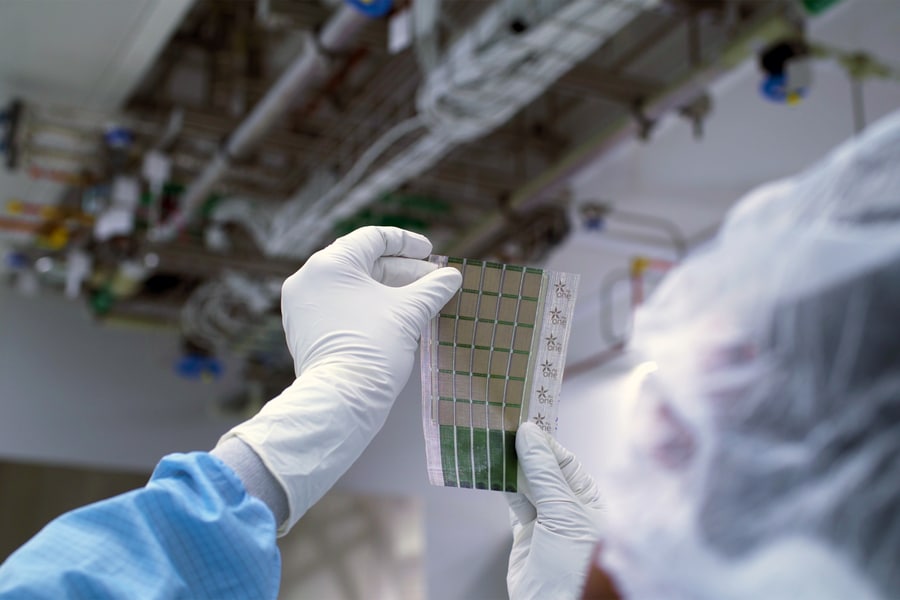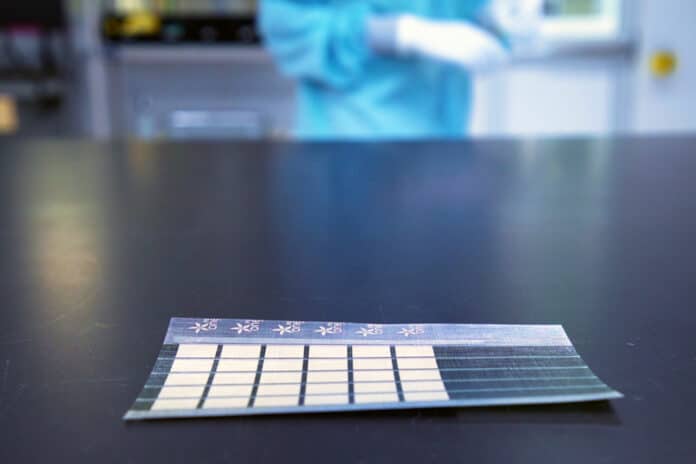Thin-film photovoltaics with functional components on the order of a few microns present an avenue toward realizing additive power onto any surface of interest without excessive addition in weight and topography. To date, demonstrations of such ultra-thin photovoltaics have been limited to small-scale devices, often prepared on glass carrier substrates with only a few layers solution-processed.
MIT engineers have developed ultralight fabric solar cells that can quickly and easily turn any surface into a power source. They developed these paper-thin solar cells using scalable solution-based printing processes for all layers.
These resilient, flexible solar cells are attached to a sturdy, lightweight fabric and are much thinner than human hair, making them simple to mount on a permanent surface. They can be transported and quickly deployed in remote regions to assist in an emergency, or they can provide energy on the fly as a wearable power fabric.
Unlike conventional solar panels, these new solar cells weigh under 1 gram over the module area (corresponding to an area density of 105 g m−2). Moreover, they generate 18 times more power per kilogram and are made from semiconducting inks using printing processes that can be scaled to large-area manufacturing.
Vladimir Bulović, the Fariborz Maseeh Chair in Emerging Technology, leader of the Organic and Nanostructured Electronics Laboratory (ONE Lab), director of MIT.nano, and senior author of a new paper describing the work said, “The metrics used to evaluate a new solar cell technology are typically limited to their power conversion efficiency and their cost in dollars-per-watt. Just as important is integrability — the ease with which the new technology can be adapted. The lightweight solar fabrics enable integrability, providing impetus for the current work. We strive to accelerate solar adoption, given the present urgent need to deploy new carbon-free sources of energy.”

As conventional solar cells are so fragile, they must be covered in glass and packaged in heavy, thick aluminum framing. This limits where and how they can be deployed.
In this new work, scientists develop thin-film solar cells that are entirely printable, using ink-based materials and scalable fabrication techniques. They employ nanomaterials as printable electronic inks to create solar cells. Working in the clean room, they coated the solar cell structure using a slot-die coater. This deposits layers of the electronic materials onto a prepared, releasable substrate that is only 3 microns thick. They later used screen printing to deposit an electrode on the structure to complete the solar module.
The printed module, roughly 15 microns thick, may then be peeled away from the plastic substrate to create an ultralight solar device.
However, such tiny, freestanding solar modules are difficult to deploy since they are readily torn and difficult to manage. The MIT team looked for a thin, flexible, and strong substrate to which they could attach the solar cells to overcome this difficulty. Fabrics were the best option since they offer mechanical resilience and flexibility with minimum additional weight.
They discovered the perfect substance: Dyneema, a composite fabric with a weight per square meter of just 13 grams. The fibers used to make this fabric are so powerful that they were used as ropes to lift the Costa Concordia, a sunken cruise ship, from the bottom of the Mediterranean Sea. They affix the solar modules to sheets of this cloth by putting a thin coating of UV-curable glue on top of it. This results in a fragile and durable mechanical solar structure.
Mayuran Saravanapavanantham, an electrical engineering and computer science graduate student at MIT, said, “While it might appear simpler to just print the solar cells directly on the fabric, this would limit the selection of possible fabrics or other receiving surfaces to the ones that are chemically and thermally compatible with all the processing steps needed to make the devices. Our approach decouples the solar cell manufacturing from its final integration.”
When tested, the device could generate 730 watts of power per kilogram when freestanding and about 370 watts per kilogram if deployed on the high-strength Dyneema fabric, which is about 18 times more power-per-kilogram than conventional solar cells. They also tested the durability of their devices. They found that, even after rolling and unrolling a solar fabric panel more than 500 times, the cells still retained more than 90 percent of their initial power generation capabilities.
Saravanapavanantham said, “A typical rooftop solar installation in Massachusetts is about 8,000 watts. To generate that same amount of power, our fabric photovoltaics would only add about 20 kilograms (44 pounds) to the roof of a house.”
Journal Reference:
- Mayuran Saravanapavanantham, Jeremiah Mwaura, Vladimir Bulovic. Printed Organic Photovoltaic Modules on Transferable Ultra-thin Substrates as Additive Power Sources. Small Methods. DOI: 10.1002/smtd.202200940
